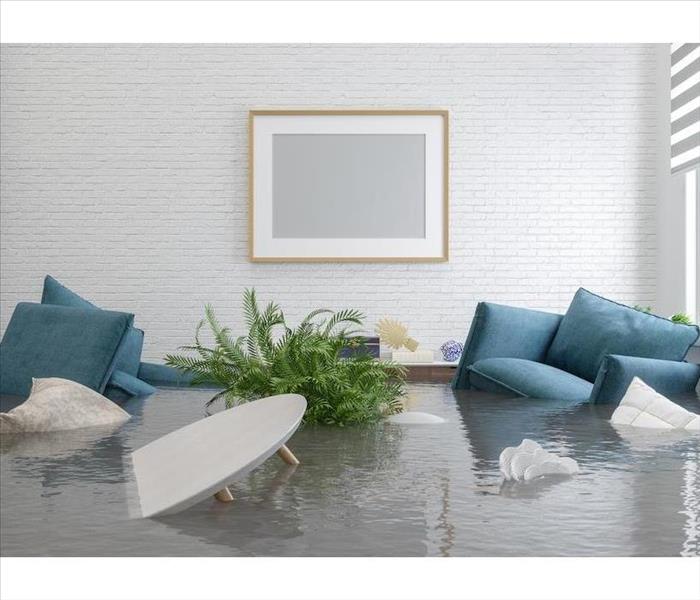How Long Will It Take to Clean the Floodwater in My Home?
4/28/2020 (Permalink)
SERVPRO Works Fast in Your Hicksville Home to Get the Flood Damage Taken Care Of
Flooding, no matter the extent, is the type of situation that Hicksville homeowners never want to experience, but it is often unavoidable, depending on the cause. Many floods bring standing water into your basement that could lead to immense damage if not addressed promptly. Calling in the help of IICRC-certified professionals ensures your home gets the prompt water restoration necessary to get it back to the pre-loss condition.
How Do You Begin Flood Damage Restoration?
When you call SERVPRO for help with flood damage in Hicksville, we arrive at your home in as little as four hours or less. We start right away on the assessment of the loss, always preparing for it to be worse than described. Any steady moisture penetrating the materials in your basement can become a catalyst for mold development as well as structural damage. This is why we have specialized plans in place that allow us to execute water restoration efforts quickly and efficiently.
How Do You Begin Water Removal?
Taking away any of the water that has pooled over the concrete flooring in your basement calls for careful selection of the best extraction devices. Our Green Fleet comes fully equipped with tools such as:
- Truck-mounted extractors that allow us to remove hundreds to thousands of gallons of water from the flood loss zone
- Submersible pumps that work best for removing standing water that is higher than two-inches deep
- Wet vacuums with wands that allow our team to address any remaining surface water
What Happens During the Drying Process?
We utilize a specialized formula for drying after a flood within your home. Our team formulates the best course of action that tells us exactly what and how many fans and air movers must be placed within the loss zone. Evaporative processes such as these usually include a combination of several types of drying machines:
- Air movers are critical throughout the drying process for any water loss
- Dehumidifiers are essential to help with basement drying, which are spaces in the home prone to elevated humidity levels
- Industrial-strength fans also help to keep the air circulating
Regardless of the number or type of drying tools used, our skilled technicians know how and when to move them around to get the best results.
Will I Need Any Repairs After the Flood?
With any ground infiltration during a flood loss situation, there can be immense damage to the blockwork that makes up the foundation of your home. This sometimes requires patches using hydraulic cement or full replacement of concrete masonry units (CMU). With strategic repair to areas of the walls that are most vulnerable, it is possible to help dry up the damp basement over the long term.
What If I Have Damage to Exterior Walls?
There are some cases after floodwaters recede that the high humidity levels within a basement can start to damage the walls. Even with the use of water extractors, dehumidifiers, and air movers, our technicians may need to move forward with further restoration efforts.
- Flood cuts just above the waterline helps to expose water pockets within the walls while removing all damaged drywall.
- Cinder Block construction homes could also hold water inside the walls. We use detection equipment to determine if there is hidden moisture that must be removed.
All of your exterior walls are checked using specialized moisture sensor technology. If high moisture levels are present, we drill holes along the bottom of the walls to bring out water from the cinderblock. Holes may also be necessary at the top of the wall to force air inside to remove moisture and expedite drying.
It may also be necessary to inspect the exterior of your home to determine if there is enough drainage going away from your building. What this does is help you to avoid high moisture conditions in the future so that water does not migrate back into the cinder block walls. Of course, our IICRC-certified technicians take note of all of these factors to share with you and your insurance company.
Will There Be Lingering Odors?
Something many homeowners worry about is lingering foul odors after a water loss event. Our technicians understand that odors and mold are essential to address as part of the cleaning and restoration process. We take all the necessary precautions so that no issues are left unaddressed. Using sophisticated equipment, we trace all of the patterns of water intrusion, leaving no cavities unturned. Deodorization and sanitization using EPA-registered cleaning agents also help us to ensure that your basement is free of harmful microbial and bacterial growth.
Some of the tools that we use to look for hidden moisture include:
- Moisture sensors to help detect moisture that may be left behind in any soft materials, including carpets and any furniture located in your basement.
- Moisture meters that feature probes allowing us to check moisture content within wall cavities and other structural materials.
- Thermo-hygrometers that help to determine the relative humidity and temperature throughout your basement.
You need flood damage help fast, and you can count on our team at SERVPRO of Hicksville/Plainview to be available 24/7 for emergency service. Call us today at (516) 773-1800, and a team will be dispatched to make it just “Like it never even happened.”






 24/7 Emergency Service
24/7 Emergency Service